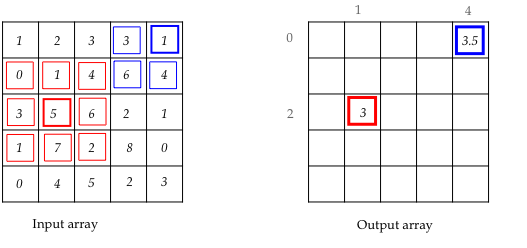Objectives and example
The goals of this assignment:
- Practice with 2D arrays.
- Using array lists.
- An open-ended project that encourages creativity.
As usual, we'll start by working together on a slightly harder problem than the ones you will do by yourself.
Consider this problem: we are given a 2D array of numbers, from which we are to compute a second 2D array of numbers (same size 2D array) in the following way: every element in the second array is the average of the values in the neighboring cells in the original array. A picture will explain this better:

Let's call the input array A and the output array B. Consider the red element on the right, which is B[2][1]. To compute the element B[2][1], look at A[2][1] and the nine neighboring cells, all shown in red in the A array. We will include the cell A[2][1] itself in the set of neighbors. The value to be assigned to B[2][1] is the average of these nine values: (0 + 1 + 4 + 3 + 5 + 6 + 1 + 7 + 2) / 9, which turns out to be 4.
In some cases, cells have fewer than nine neighbors, like the blue cell A[0][4] shown, which has a four-cell neighborhood. Thus, the average to be stored in B[0][4] is: (3 + 1 + 6 + 4) / 4 = 3.5.
A1.1 Exercise: At this point do not write any code. Try to sketch out a solution in pseudocode. See how far you get before reading through the solution.
And now, on to your assignment. Good luck!
In this exercise, we'll use a slight variation.
You will take as input a word and
print all the valid three-letter words one can make with its letters,
but where the letters of the three-letter word occur in the order
as in the original word. Thus,
from "conserve", the three letter word "one" is acceptable because
the occur in order:
Call your method
Many modules ago, you used DrawTool for your first art project with
programming. Now, knowing all that you know, it should be possible
to create a more sophisticated art project with animation, with
multiple types of objects, with some "interacting physics" between
the objects, and other ideas. The goal of this part of the
assignment is to do exactly that: end the course with a
visually arresting, animated art project.
Write your code in
MyFinalArtProject.java.
A1.0 Audio:
Assignment problems
public static boolean isValidChessBoard (int[][] board)
{
// Returns true or false, depending on whether the array
// satisfies certain properties.
}
Although the standard chessboard is 8×8, we will allow any
N×N as long as N>3. Here's an example:
int[][] A = {
{0,1,0,1},
{1,0,1,0},
{0,1,0,1},
{1,0,1,0}
};
The basic properties to be satisfied are:
Download TestChessBoard.java
and use it for testing your program. Note: a smart thing to do
while testing is to comment out all but one test and get your
program working test-by-test.
conserve
But the three letter word "son" is not acceptable because
those letters do not occur in the order they exist in "conserve".
public static int threeLetterFinder (String inputWord)
{
ArrayList<String> words = WordTool.getUnixWordsAsList ();
// Uses the letters of inputWord form all possible valid
// three-letter words that occur in sequence. Define valid
// as: it must be in the list of unix words above.
// Also: print the total number of 3-letter in-sequence combinations.
}
And write your program in
ThreeLetterFinder.java.
Thus, the output for "conserve" should be:
8 three-letter subwords for 'conserve' out of 56 possible combinations
>> con
>> cos
>> one
>> ore
>> nee
>> see
>> ere
>> eve
You will also need
WordTool.java
and
words.txt
DrawTool.startAnimationMode ();
for ( ... ) {
// Draw a scene slightly different from the
// scene in the previous iteration
DrawTool.animationPause (100);
}
DrawTool.endAnimationMode ();
What makes it an animation is that the objects on the drawing should
be moved only slightly, to create the effect of motion.
Write your responses in
assignment1.pdf.